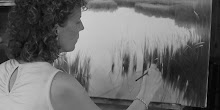


Last week, I was lucky enough to be able to take a workshop with well-known artist Scott Tallman Powers in Easton, Maryland. Scott is a signature member and boardmember of the Oil Painters of America and founded The Plein Air Painters of Chicago. He also teaches at The Palette & Chisel Academy of Fine Art in Chicago. His paintings are like pure poetry to me, beautiful scenes and portraits with a certain mood or atmosphere that touch your heart.
This 5-day Portrait & Figure worskhop was organized by South Street Art Gallery in Easton, MD so it promised to be a good one! After the gallery owner (and artist) Nancy Tankersley had asked Scott what our schedule for the week would be, he answered: "Schedule? We're going to paint, paint, paint!" He kept his promise....we painted from 9am till 4pm every day and afterwards, we were welcome to look over his shoulder during his own outdoor painting sessions.
The week was divided into two subjects: the first two days we would paint a portrait and the last three days we're going to focus on the nude figure. Scott would start with an extensive demo of half a day. He would be talking about the importance of measuring accurately, rather than trying to capture a likeness! Measuring by using 'plumb lines' and comparing distances to eachother, rather than using inaccurate 'rules' (such as the eyes are always in the middle of the face). These rules don't work, since people are all different! He also emphasized the importance of putting down the darkest dark, the lightest light and the brightest color right away. This will give you the opportunity to measure all other values and colors against these 'guidelines'. The first layer of oil paint is put on rather thin (almost 'scumbled'), but in the correct value & local color, subsequent layers of subtle color nuances are added with more paint. He also stressed the importance of edges. Sharp edges are created by big value-changes (f.e. difference between foreground value and background value) and bigger plane changes (f.e. sharp edge of the nose instead of the soft curve of a cheek). Both a portrait ,as well as a figure, requires you to work from large shapes to smaller shapes and from the large value and temperature changes to more subtle changes. The trick is also not to stare at one value or color too long...this will make you see all kinds of different colors! Scott told us to look at an area by squinting and using your peripheral vision, rather than to stare at it directly. This will make you compare the value and color to another area closeby and relate every area correctly.
The models had a 5 minute break every 25 minutes, but we probably needed the breaks more than they did! It took all our energy to stay focused, keep measuring, comparing, squinting and mixing. Scott was extremely encouraging and very generous with his information and experience. He gave us so much to think about that it will take us quite a long time and lots of practice to digest the information for it to become 'second nature'....but if we can get any closer to painting like Scott in the future, it will be definitely worth it! Check out his work by going to: http://www.scottpowersfineart.com/.




